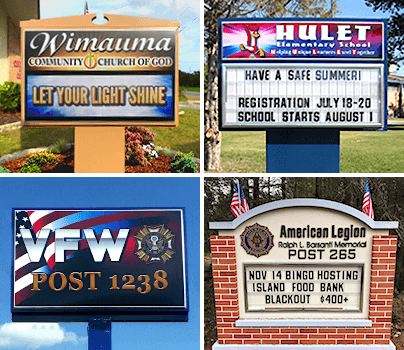Signs are so widespread we hardly notice them. That is until we're looking for one and then we only note that in passing. We don't realize their effect on us, which is one reason why they're so effective.
However, it is precisely because they are so commonplace that many merchants take them for granted. Obviously, most small business owners know they need a sign but they think of them as merely a marker identifying the business. As a result they are unaware of and underutilize the earning potential of signage. In order for the independent merchant to fully realize the potential earnings of signage, he or she must look at signage not just as a way of marking the business but also as a way of marketing the business.
Your on-premise sign should identify your business, mark its location, and convey the right image of your company. But, the most important thing it should communicate is what you are selling. At a minimum, your sign should Attract new customers, Brand the business and Create impulse sales. For more on the ABCs of Signage, visit our post here.
Marketing to Your Customers
Different types of businesses have different signage needs because they serve different purposes and reach out to different customers. To make sure your signage is specifically marketing to your customers you must first determine your category of business. At one end of the business category spectrum are companies that satisfy specific and infrequent customer needs. At the other end are businesses that fulfill general and frequent needs. An effective sign will employ different marketing strategies depending on the type of business and the needs of its customers. When businesses fall in between the two extremes, they will need to use a combination of methods.
Infrequent Needs Branding Sites
Businesses that offer products or services that meet specialized or infrequent needs must develop top-of-mind awareness so people remember the business when those needs arise. Examples of this kind of business include veterinarians, appliance and electronics stores, locksmiths, medical and dental offices, real estate offices, and accounting and bookkeeping firms. These businesses must focus on branding their site. To reinforce this effort, the signage itself must be designed to project the right image for the business and have that image be recalled. When a customer walks through the door of one of these businesses, it is likely he or she has already noticed the business's sign, developed an opinion about the business, and remembered the business when it was needed.
Studies show that electronic message centers and variable message displays increase memory of a business. People are curious to see what the sign will say each time they pass it, so they keep looking at it. When a sign is a source of information people want, it takes on more significance in their memory, branding your site.
Frequent or Impulse Needs
Businesses designed to meet frequent or impulse needs must reach out and pull people in on the spot. Examples of these include grocery stores, gas stations, hotels, video stores, restaurants, convenience stores, and car washes. Many of these business's customers need to make a quick decision to stop. Therefore, their signage should be eye-catching with a brief, simple message that can be read and understood quickly. The businesses must be noticed and recognized at precisely the right time by those ready to buy. Often these businesses rely heavily on attracting tourists and need to be sure those unfamiliar with the business can tell right away what is sold there.
The typical McDonald's is a good example. The "golden arches" are such familiar icons that the McDonald's sign can be easily recognized long before the sign's lettering can be read. This gives a driver plenty of time to notice the sign, make a decision to stop, and safely maneuver through traffic. An independent fast food restaurant with a poorly-designed sign that is hard to see, hard to read, and hard to understand, will have great difficulty competing for the frequent need customer even if the food, service, and pricing are superior.
If your sign is going to convince the impulse customer to stop at your business, it must be designed so that the important information is easily recognized at a glance. People driving down the street can take in a great deal of information. Seventy-five percent will pick out the key word on a sign the first time they pass it. Make sure the first time someone reads your sign they immediately understand the most important information – what you are selling. Any additional information should be designed to keep your repeat customers interested in your sign and your business so they remember to come see you again.
Because we read from the top down and left to right, the key word, graphic, or logo should be located at the top of the sign and read from left to right. Otherwise, the reader can get confused and take longer to understand the sign's message. This delay can mean the person who is seeing the sign for the first time is unable to read and react to it before driving past your business.
Credit:
http://www.signs.org/Resources/Signage101/SignsasMarketing.aspx
